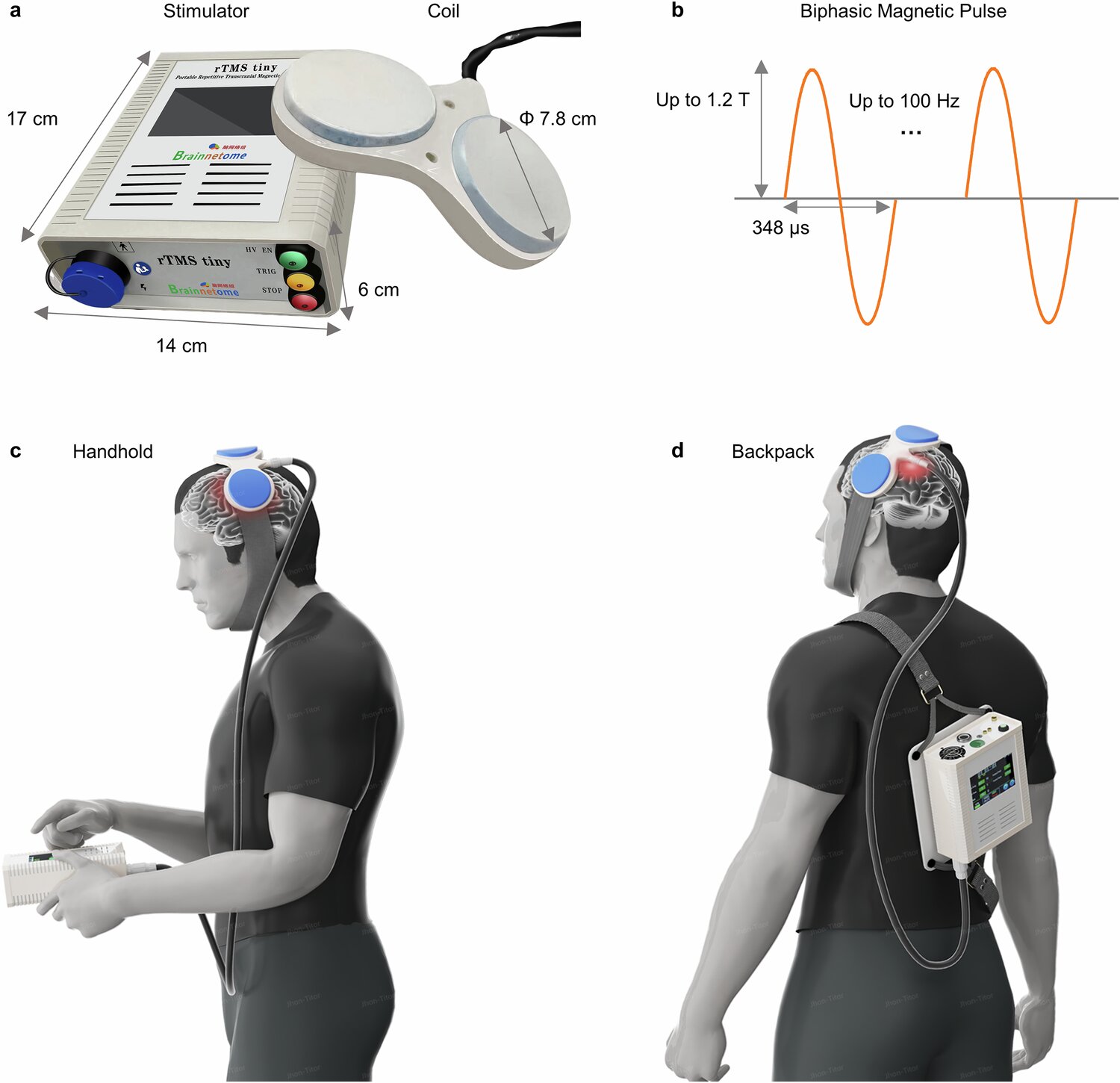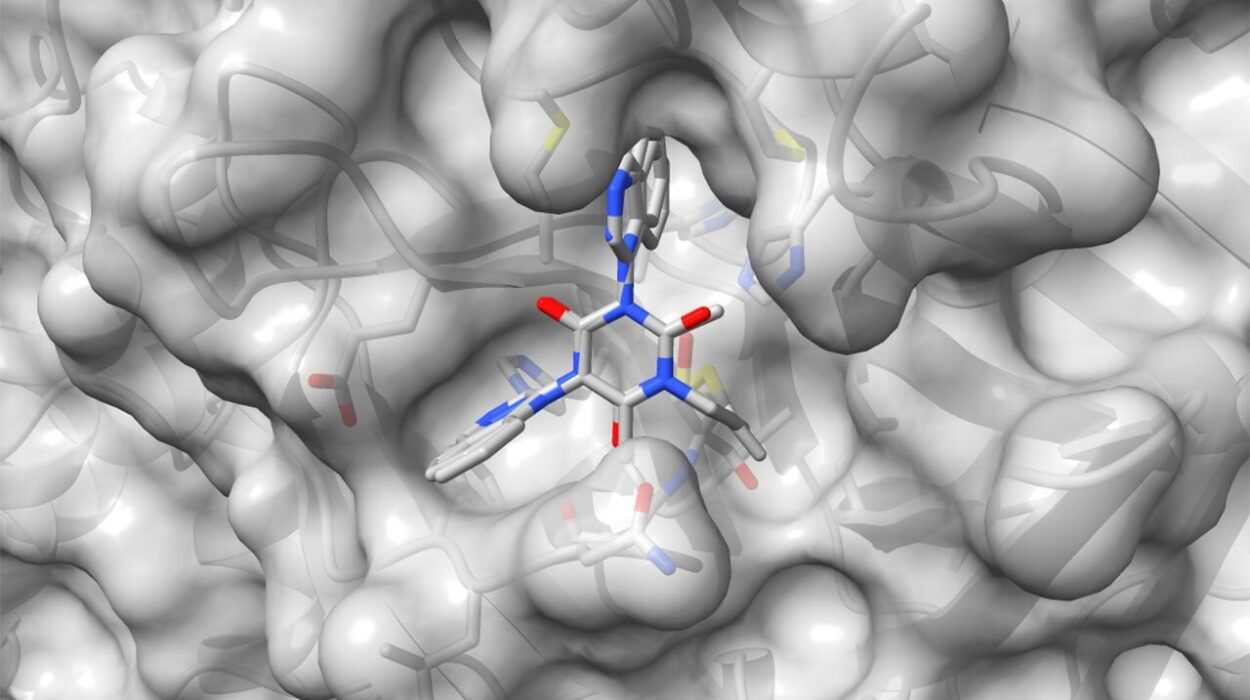In a groundbreaking development, researchers at the Institute of Automation of the Chinese Academy of Sciences have designed a compact, battery-powered brain stimulation device capable of delivering therapeutic magnetic pulses while a person goes about their daily activities, including walking. This new system is set to revolutionize the way neurostimulation therapies are administered, offering an innovative solution to patients who require repetitive transcranial magnetic stimulation (rTMS) for a variety of neuropsychiatric disorders.
Repetitive transcranial magnetic stimulation has been recognized as a vital tool in the treatment of conditions like depression, stroke-related motor impairment, and a range of cognitive disorders. It is also a key technology used in neuroscience research, particularly in studying brain functions related to cognition and motor skills. However, despite its potential, existing rTMS systems have been limited to stationary, clinical settings due to their bulky designs and dependence on continuous power sources. These limitations have made it difficult for patients to receive treatment during natural activities like standing, walking, or performing daily tasks, making at-home or on-the-go treatments impractical.
This major drawback has also hindered research on how brain activity changes in dynamic environments. Until now, investigations into brain responses during free behaviors have been incomplete because current devices cannot function during activities like walking, which are often critical for accurate, real-world studies. Moreover, patients undergoing regular rTMS treatment are typically required to attend daily hospital visits over extended periods, which can be both costly and inconvenient, often leading to poor adherence to treatment protocols. A wearable, battery-powered device capable of delivering therapeutic magnetic pulses with the intensity necessary for direct neuronal stimulation has never before been realized—until now.
A Breakthrough in Wearable Brain Stimulation
The study, titled A Wearable Repetitive Transcranial Magnetic Stimulation Device and published in Nature Communications, showcases a revolutionary portable brain stimulation system that overcomes the limitations of traditional devices. By combining lightweight coil engineering with advanced high-voltage pulse technology, the research team has successfully created a system capable of delivering effective therapeutic stimulation during normal human movement.
The device is designed to be worn while walking or standing, offering a new level of convenience and accessibility for patients undergoing treatment. A key breakthrough was developing a head-mounted coil capable of producing strong, therapeutic magnetic fields using only battery power. Traditional rTMS systems are power-hungry and require high-voltage electricity from the grid, generating excessive heat and being far too bulky for wearable applications. To address these issues, the researchers engineered a compact figure-8 coil with specialized magnetic core materials that enhance the strength of the magnetic field while reducing the device’s energy requirements.
This innovative design is coupled with a small, lightweight control and power unit that weighs just over one kilogram. This unit is secured across the back using shoulder straps, and it incorporates a high-power converter capable of delivering pulses of up to 1,600 volts and 500 milliamps—using just an 18-volt battery. Remarkably, the system recovers energy after each pulse, which extends battery life and minimizes heat generation, making it safe for prolonged use.

Design and Testing: A New Era for Brain Stimulation
The technical validation of the device was a crucial step in ensuring its effectiveness and safety. The system underwent rigorous testing, including simulations of electric field strength in human head models and comparisons with commercial devices. Key performance metrics, including pulse width, magnetic flux intensity, temperature rise, and repetition rates, were all measured and compared with existing, stationary systems.
The device’s testing phase also included human trials. A group of 15 healthy adults between the ages of 25 and 40 participated in testing the system. The wearable coil was mounted onto the participants’ heads using a padded elastic strap that wrapped under the chin for added stability, ensuring that the device could be worn comfortably during both seated and walking conditions. In these trials, participants received magnetic stimulation targeting their motor cortex. To verify that the brain was responding to the stimulation, motor-evoked potentials were recorded from muscles in the hands and legs, confirming that the magnetic pulses reached the motor areas of the brain.
One of the most exciting findings from these trials came when participants were walking. The muscle responses observed in this dynamic condition were more than double the amplitude compared to when they were at rest. This confirmed that the device was capable of delivering effective, therapeutic stimulation, even during natural movement—an important milestone in making rTMS treatments more accessible to people who need them.
Impressive Performance and Practical Application
The new wearable rTMS device was able to generate magnetic pulses with a strength of up to 1.2 Tesla, with a pulse width of 348 microseconds—levels comparable to conventional commercial brain stimulation systems. The system operated at frequencies of up to 100 Hz, supporting widely used stimulation protocols, including 10 Hz and theta burst patterns, which are commonly employed in clinical treatments.
A major advantage of the system is its battery-powered operation, which allows over 8,000 pulses at moderate intensity on a single charge. Even during high-frequency use, coil temperatures remained below the safety thresholds set by international medical device standards. Infrared imaging confirmed that the heat distribution was uniform, and no overheating occurred, even after extended sessions.
Although all testing was conducted in controlled laboratory settings, the researchers are optimistic that future versions of the device could support home-based or mobile use, pending further developments in safety protocols and remote supervision systems. This would make rTMS treatments much more convenient and accessible, potentially eliminating the need for daily hospital visits and allowing patients to receive therapy in the comfort of their own homes.
Looking to the Future: Adaptive, Closed-Loop Systems
The researchers also have ambitious plans for the future of this device, with the potential to integrate it with brain-monitoring systems for real-time feedback and adaptive stimulation. This would create a closed-loop system where the intensity and frequency of the magnetic pulses could be adjusted based on the patient’s brain activity, further personalizing treatment. Such adaptive stimulation could revolutionize therapeutic applications, particularly in conditions like depression, stroke rehabilitation, and cognitive disorders.
By using brain activity data to guide treatment, the system could optimize therapeutic outcomes and make the treatment process more efficient. For example, the system could dynamically adjust stimulation parameters based on the patient’s current brain state, ensuring that the magnetic pulses are delivered precisely when needed, and enhancing the effectiveness of the therapy.
Implications for Neurotherapy and Research
This breakthrough in wearable brain stimulation has significant implications for both therapeutic applications and neuroscience research. For patients, it means the possibility of receiving treatments while maintaining their normal routines, reducing the inconvenience of traditional hospital-based therapy and potentially increasing treatment adherence. Moreover, the mobile nature of the device opens up new opportunities for long-term treatment and monitoring, as well as more flexible research settings.
For researchers, this new device offers an exciting opportunity to study brain activity in dynamic environments. Because the device allows for stimulation during walking and other natural behaviors, it could provide valuable insights into how the brain functions in real-world conditions. It could also facilitate research into how brain stimulation can be used to treat a wider range of conditions, from mood disorders to motor impairments, in ways that were previously impossible with stationary equipment.
The integration of real-time brain activity monitoring with adaptive stimulation will likely drive the next wave of innovation in brain-based therapies, allowing for more precise and personalized treatments. As more research is conducted and the device evolves, we may see even more breakthroughs in the understanding and treatment of neuropsychiatric and cognitive disorders.
Conclusion
The development of this wearable, battery-powered brain stimulation device represents a significant leap forward in both the field of neurostimulation and in how medical treatments can be delivered. By combining cutting-edge technology with an understanding of how the brain responds to stimuli during natural movement, this device is paving the way for more accessible, effective, and patient-friendly therapies. Whether used for treating conditions like depression and stroke-related motor impairments or for advancing research into cognitive functions, this innovation has the potential to transform the landscape of neuroscience and therapeutic treatment.
Reference: Zihui Qi et al, A wearable repetitive transcranial magnetic stimulation device, Nature Communications (2025). DOI: 10.1038/s41467-025-58095-9






